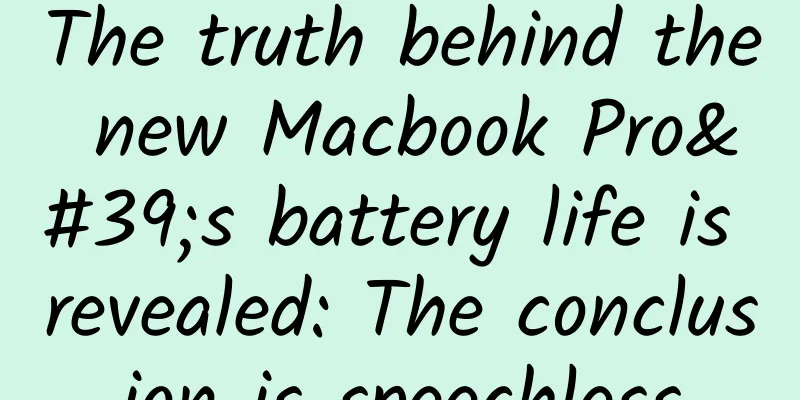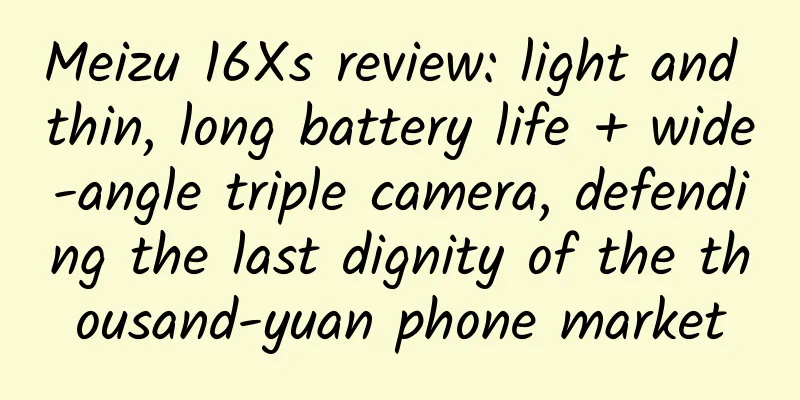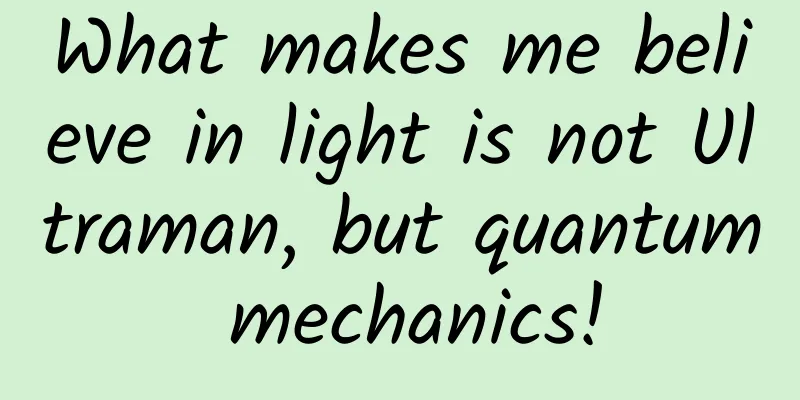The truth behind the new Macbook Pro's battery life is revealed: The conclusion is speechless

|
Not long ago, Apple began to urgently recruit engineers related to battery technology, which shows that the battery life problem of the 2016 MacBook Pro that was exposed a few days ago has received its attention. However, it will take a long time for these actions to be effective. For now, we still have to understand what is going on with this year's MacBook Pro and whether we have any solutions. The mystery of MacBook Pro battery life It is really hard to say clearly about the battery life of this year's new MacBook Pro. Since people noticed that its battery life performance seemed to be lower than what Apple advertised at the press conference, the official removed the remaining battery life display that had always existed in the latest macOS 10.12.2 version, on the grounds that its inaccuracy might mislead users. Not long ago, it was reported that some users of the new MacBook Pro reported that after upgrading their devices to the latest version, their battery life returned to the original expected level. However, a few days later, Apple commented through foreign media ArsTechnica that they did not adopt any solutions related to improving battery life in this system update. It is understood that Apple also "repeatedly emphasized this point", presumably because it is worried that users will have unnecessary misunderstandings. Although the ready-made solutions are not satisfactory, Apple's attention to battery life issues is not false. Last week, Apple released three consecutive job announcements, seeking three types of talents: system energy consumption control architect, battery algorithm analysis engineer, and battery testing and processing engineer. Obviously, what Apple needs to do is to actively find better ways to manage and optimize device energy consumption and maximize battery life under the condition that existing battery technology cannot make breakthroughs. However, it will take until next year or even the year after next for Apple's recruitment to show results. Is there anything else we can do now? So let's analyze why the new MacBook Pro has battery life problems and why the situation will improve after the updated version. Unraveling the mystery First, let's take a look at how Apple tested it to come to the conclusion that the battery life can reach 10 hours. In fact, the technical specifications on the official MacBook Pro page have already told us the exact information: "Battery life during wireless Internet operation is tested by wirelessly browsing 25 popular websites, with the display adjusted to 75% of maximum brightness or 12 clicks from minimum brightness. Battery life during iTunes movie playback is tested by playing HD 1080p high-definition video, with the display adjusted to 75% of maximum brightness or 12 clicks from minimum brightness. Battery life during standby is tested by connecting the system to a wireless network and logging into an iCloud account, entering standby mode while keeping Safari and Mail applications open, and setting all system settings to default." In general, the settings used by Apple are relatively close to the settings we usually use. However, it should be noted that such tests are more used to compare the battery life differences between different products, and do not represent our daily use, because everyone's daily computer use environment will definitely be much more complicated than the test. What is the difference between this year's MacBook Pro and previous years? First of all, although it is thinner, it comes with a smaller battery capacity. However, its screen power consumption is lower than before. The 15-inch MacBook Pro also has its own independent GPU. The battery capacity of the new MacBook Pro has indeed been reduced - the 13-inch version has dropped from 74.9 WHr in the previous generation to 49.2 WHr; the 15-inch version has been reduced from 99.5 WHr to 76 WHr. The reductions are 34% and 24% respectively. If you want to ensure that the device can still have a satisfactory battery life in this case, then the three power-hungry CPUs, GPUs, and displays must be optimized. Apple says that the screen's energy consumption has been reduced by about 30%, but we need to note that this 30% does not mean that the overall system energy consumption has been reduced by that much. On the CPU side, we can only blame Intel. In fact, from Haswell to Broadwell to Skylake, their power consumption has not improved much. The TDP (thermal design power) of the processors used in the MacBook Pro from 2014 to the present is the same: 28W for the 13-inch version; 45W for the 15-inch version. Although the TDP parameter is mainly used to indicate how much heat dissipation capacity a chip needs to reach the most suitable conditions, it still allows us to draw such a conclusion. The actual test results are the same. Although the new processor certainly consumes less energy, the difference is negligible. Then there is the GPU, which is more obvious on the 15-inch version because it has its own independent 35W TDP GPU. One thing worth noting is that although the new MacBook Pro has the feature of automatically switching between discrete graphics and integrated graphics to save energy, this still consumes more power after all, because Apple does not allow users to manually switch integrated graphics. What is the conclusion? So we can roughly summarize it here: the battery capacity of the new MacBook Pro is smaller than before, and the only place where Apple can effectively reduce energy consumption to make up for the loss is that the screen energy consumption has been reduced by 30%. Does the newly added Touch Bar need to be blamed? The answer is no. The T1 chip it uses is quite related to the Apple Watch, and the AMOLED screen of the Touch Bar is similar to the Apple Watch in a sense. Considering that the Apple Watch Series 2 only has a 1.03WHr battery and can still last for nearly a whole day, the impact of the Touch Bar on the laptop is minimal. We must pay attention to one point, that is, people's complaints about the MacBook Pro frequently appear in the first few days after receiving the device. At that time, whether it was copied directly or synchronized through iCloud, everyone had a lot of data to transfer. In addition, Spotlight's indexing service, iCloud and the local photo library also need to start sorting out the content. Frequent uploading and downloading, the battery life of the new machine in the first few days does not represent its normal performance in this sense. So we can probably use this to explain the strange phenomenon that people think the battery life has indeed increased, even though Apple has clearly stated that the macOS 10.12.2 update has nothing to do with the improvement in battery life - the new version was pushed just in the time period when the new machine was automatically synchronized and set up. Maybe the battery life had already improved before the update, but the version upgrade made a deeper impression on people, creating an illusion. What can we do? Considering that updates to improve battery life will not come for a while, we can only consciously save some electricity ourselves. Keeping a relatively low but acceptable screen brightness, and turning off applications and web tabs that are not used in a short period of time are all good ways. In addition, if you are not in urgent need of rich plug-ins, using the Safari browser is a good choice, because this is a browser directly integrated into the system, and the energy saving optimization will be relatively much better. If you don't mind the trouble, use the activity monitor from time to time to monitor energy consumption and see which application consumes more power. It should be noted that the battery life of the new MacBook Pro has indeed decreased compared to the old model, but the decline does not seem to be large. We can see this from the fact that people reported that the battery life has returned to normal levels after the update.As a winner of Toutiao's Qingyun Plan and Baijiahao's Bai+ Plan, the 2019 Baidu Digital Author of the Year, the Baijiahao's Most Popular Author in the Technology Field, the 2019 Sogou Technology and Culture Author, and the 2021 Baijiahao Quarterly Influential Creator, he has won many awards, including the 2013 Sohu Best Industry Media Person, the 2015 China New Media Entrepreneurship Competition Beijing Third Place, the 2015 Guangmang Experience Award, the 2015 China New Media Entrepreneurship Competition Finals Third Place, and the 2018 Baidu Dynamic Annual Powerful Celebrity. |
<<: Samsung Note7 "resurrected"? Usage rate exceeds the sum of three best-selling models
>>: US computers must install anti-pornography software: you can pay $20 to unlock it
Recommend
Brand marketing method, use these 4 steps!
In life, we often see the success of others and t...
How much is the price of Nanjing Audition Club? Which one has a better price/performance ratio?
Reservation arrangements for Nanjing audition clu...
Sniping Samsung, why does Skyworth dare to say that curved LED TVs are a technological regression?
How thin can a TV be? With the launch of Skyworth...
Rebuilding the next Alibaba, Jack Ma’s glory and ambition
[[145683]] At present, Alibaba Group has a market...
How to play short video promotion marketing nodes
As a person engaged in short video promotion and ...
Summary of the channel characteristics of advertising on Momo, iQiyi, Kuaishou, etc.!
What are the characteristics of information flow ...
A complete analysis of the Toutiao search account setup and delivery ideas
As a new search platform launched this year, Tout...
2 cases to teach you the correct approach to user operations!
Everyone knows about user operation , but most pe...
Short video operation: How to achieve 1.6 million+ fans?
In short video operations , if you want to do a g...
SEO optimized website has been included but is not ranked? How long does it take to be included and ranked?
Bosses who are familiar with SEO optimization kno...
Why doesn't Samsung S7 use USB Type-C?
As we all know, USB Type-C will replace the exist...
Tips for creating popular short videos, how to create explosive short videos?
Nowadays, people of all ages like to watch short ...
Ten hidden tricks of WeChat that most people don’t know
1. Send original image/video It is well known tha...
How to solve the problem of self-driving cars being frequently forced to stop by experienced drivers
We only know that autonomous driving has become a...
Zhihu App product operation experience analysis report!
From a niche elite community to a knowledge mento...









